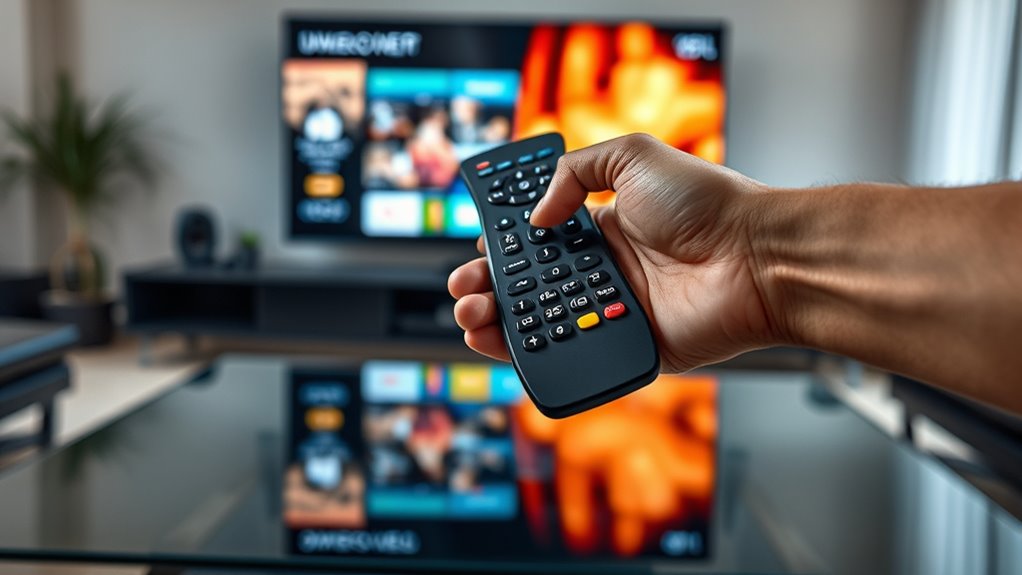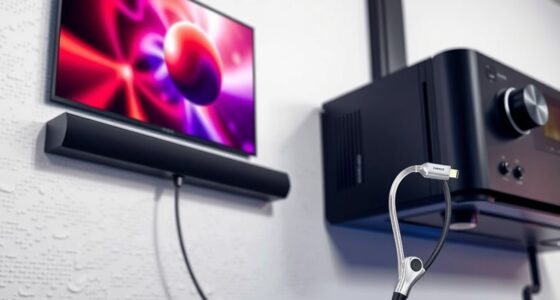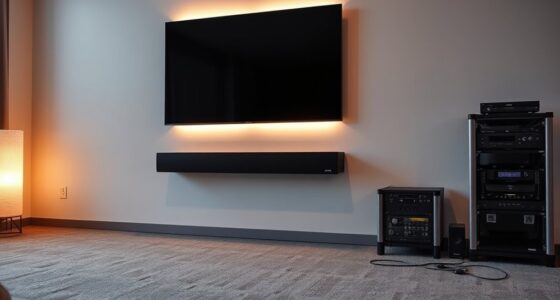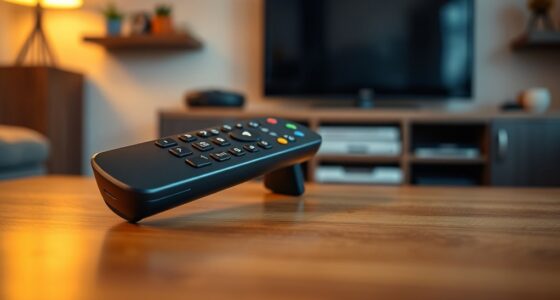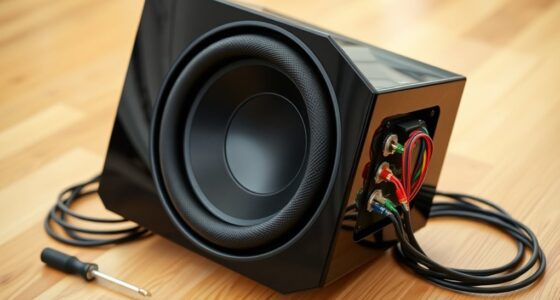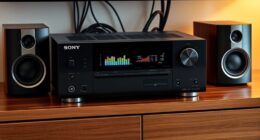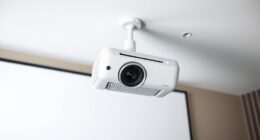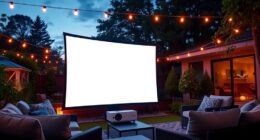Universal remote controls are often misunderstood, with myths about flawless, instant operation or universal compatibility. In reality, they require proper setup, programming, and understanding device compatibility to work effectively. Learning key terms like macros, pairing, and firmware updates helps you maximize their potential. Recognizing these facts guarantees you get the most reliable control, and exploring further can help you choose and optimize a remote that truly fits your needs.
Key Takeaways
- Many believe universal remotes control all devices instantly without setup, but proper programming and compatibility are essential.
- Features like auto-programming and voice control are helpful but may require manual adjustments and aren’t foolproof.
- Compatibility across device brands, ease of setup, and security features are critical considerations for effective remote control.
- Custom macros and smart home integration maximize a universal remote’s functionality and streamline multiple device operations.
- Regular firmware updates and organized customization enhance performance, ensuring the remote meets user needs effectively.
Common Misconceptions About Universal Remote Capabilities

Many people assume that universal remotes can automatically control every device in their entertainment setup without any setup or programming. This is a common remote control myth that leads to frustration. In reality, universal remote limitations mean you often need to program or code the remote to work with your specific devices. Not all devices are compatible out of the box, and some features may not be fully supported. While many universal remotes are versatile, they don’t instantly control everything perfectly. Understanding these remote control myths helps manage expectations and saves you time. You’ll need to invest a little effort in setup, but once configured, a good universal remote simplifies your entertainment experience. Don’t fall for the myth that they work perfectly without any initial setup. Additionally, understanding device compatibility is crucial for ensuring your remote functions as intended.
Key Features to Look for in a Universal Remote
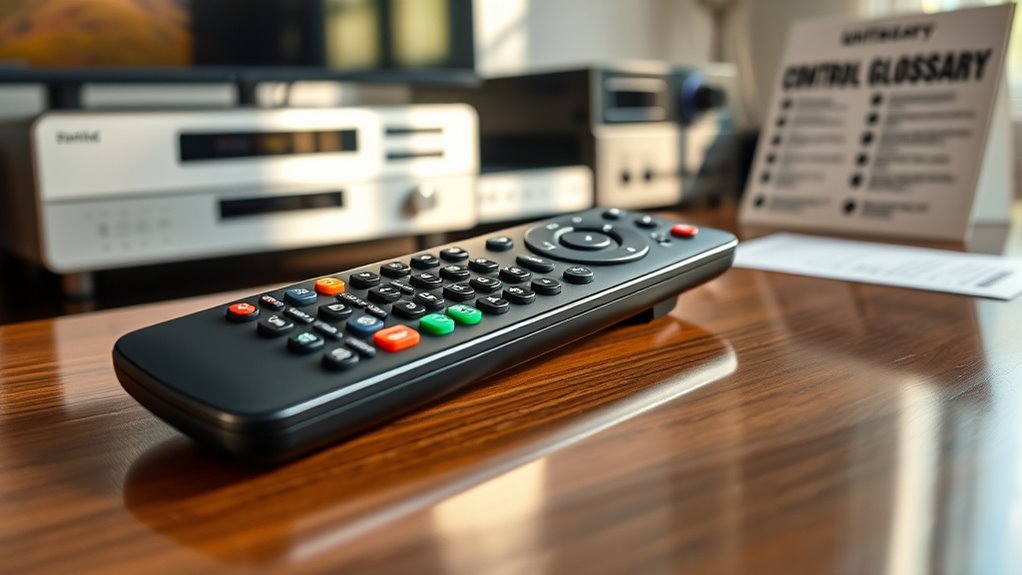
When choosing a universal remote, you want one that covers a wide range of devices, so compatibility is crucial. A user-friendly interface makes setup and daily use easier, while advanced programming options give you more control. Considering these features helps guarantee you get a remote that fits your needs perfectly. Additionally, understanding the importance of acne patches can be helpful when seeking effective skin treatment options.
Compatibility Range Expansion
Expanding the compatibility range of a universal remote guarantees it can control more devices across different brands and technologies, offering greater convenience and value. Look for a remote with a wide device compatibility list, ensuring it works with your TV, sound system, streaming devices, and more. A good remote should also feature an extended remote signal range, so you don’t have to be near your devices to operate them. This expansion means fewer remotes cluttering your space and less hassle switching between controls. Confirm that the remote supports the specific brands and models you own. Additionally, considering device compatibility features can help ensure your remote adapts to your setup now and as you upgrade devices later, maximizing its usefulness and saving you time and frustration.
User-Friendly Interface Design
A user-friendly interface design makes operating your universal remote simple and intuitive. Look for one with an ergonomic design that fits comfortably in your hand, reducing strain during extended use. Clear, well-labeled buttons help you quickly find what you need without frustration. An intuitive layout minimizes the learning curve, so you won’t waste time figuring out how to control different devices. Aesthetic appeal also matters; a sleek, modern look can enhance your entertainment setup’s overall vibe. Some remotes feature backlit buttons for easier use in low light, and tactile differentiation helps you operate controls without looking. Additionally, incorporating good lighting ensures you can see all controls clearly at any time. Ultimately, a well-designed interface streamlines your experience, making controlling multiple devices effortless and enjoyable.
Advanced Programming Options
Looking for a universal remote that offers advanced programming options? You want features like customizable macros, voice command integration, and smart home connectivity. These options let you streamline your entertainment and control multiple devices effortlessly. A remote with robust programming capabilities can set up complex sequences, reducing manual inputs.
| Feature | Benefit |
|---|---|
| Voice command | Hands-free control, easier access to devices |
| Smart home integration | Manage lights, thermostats, and more from one remote |
| Custom macros | Automate routines for quick device setup |
These features enhance your control experience, turning a simple remote into a centralized hub for your smart home ecosystem. Look for advanced programming options that match your tech needs.
Understanding the Control Glossary: Terms You Should Know
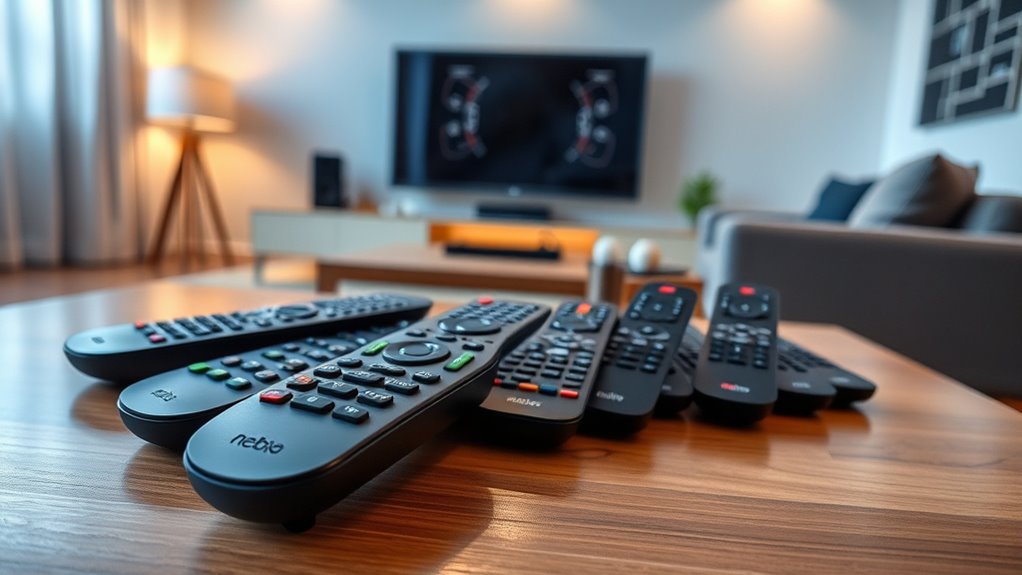
Understanding key remote terms and common control features helps you use your universal remote more effectively. Knowing what functions like macros or input switching mean saves you time and frustration. Let’s explore these essential concepts so you can get the most out of your device. Being aware of emotional support strategies can also help you manage stress and enhance your overall experience with technology.
Key Remote Terms
Ever wondered what all those buttons and terms on your remote actually mean? Understanding key remote terms helps you use your device more effectively. For example, a remote signal is how your remote sends instructions to your device, often via infrared or Bluetooth. Device pairing is the process of connecting your remote to a specific device, ensuring commands go to the right place. Additionally, knowing about projector technology can help you select the best remote features for your home theater setup.
Key points to remember:
- Remote signal: The method your remote uses to communicate with devices.
- Device pairing: The setup process that links your remote to a device.
- Button functions: Labels like “Power,” “Input,” or “Volume” tell you what each button controls.
Knowing these terms makes troubleshooting easier and enhances your overall control experience.
Common Control Features
Many remote controls include a variety of common features that simplify device management and improve your viewing experience. Voice control is a popular feature, allowing you to change channels, adjust volume, or find content with simple spoken commands. This makes navigation faster and more convenient, especially when your hands are full. If you have a smart home setup, some remotes can integrate with your devices, giving you centralized control over lighting, thermostats, and entertainment systems. Universal remotes often include macro buttons to execute multiple commands with a single press, streamlining your entertainment experience. These features help reduce clutter, eliminate the need for multiple remotes, and make managing your devices more intuitive and effortless. Control integration can enhance your overall home automation setup, providing seamless connectivity between your entertainment and smart home devices.
Compatibility and Device Coverage: What Really Matters
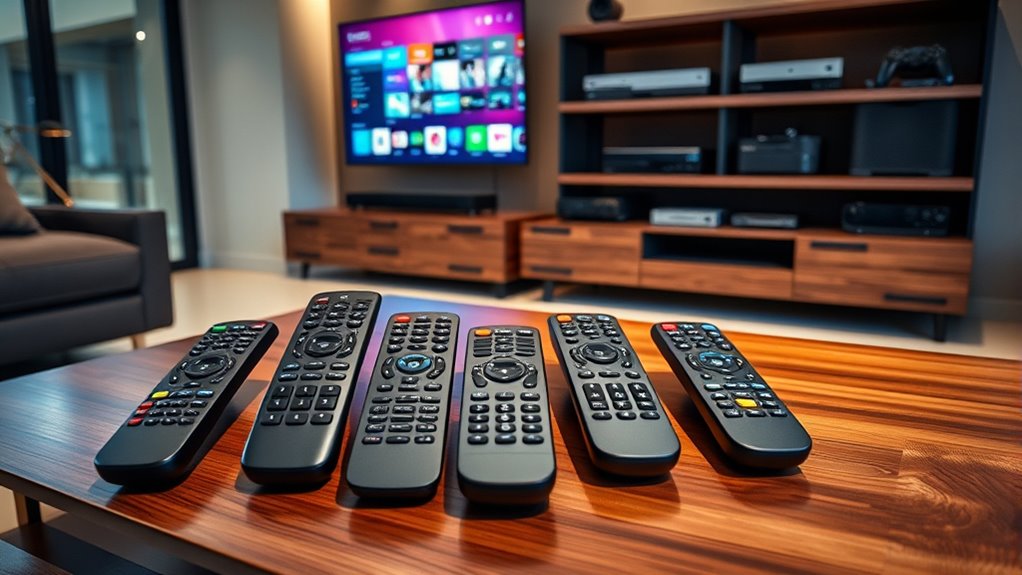
When choosing a universal remote, focusing on compatibility and device coverage guarantees you get a model that truly meets your needs. Ensuring the remote supports your device brands and models is essential for smooth operation. Look for remotes with broad device coverage to control multiple gadgets—TVs, sound systems, streaming devices, and more. Brand compatibility matters because some remotes work best with specific brands or ecosystems. To avoid frustration, verify that the remote lists your devices or brands explicitly. Additionally, understanding the potential security vulnerabilities in remote control systems can help you select devices with robust security features to protect your data and privacy.
The Role of Programming and Setup Processes
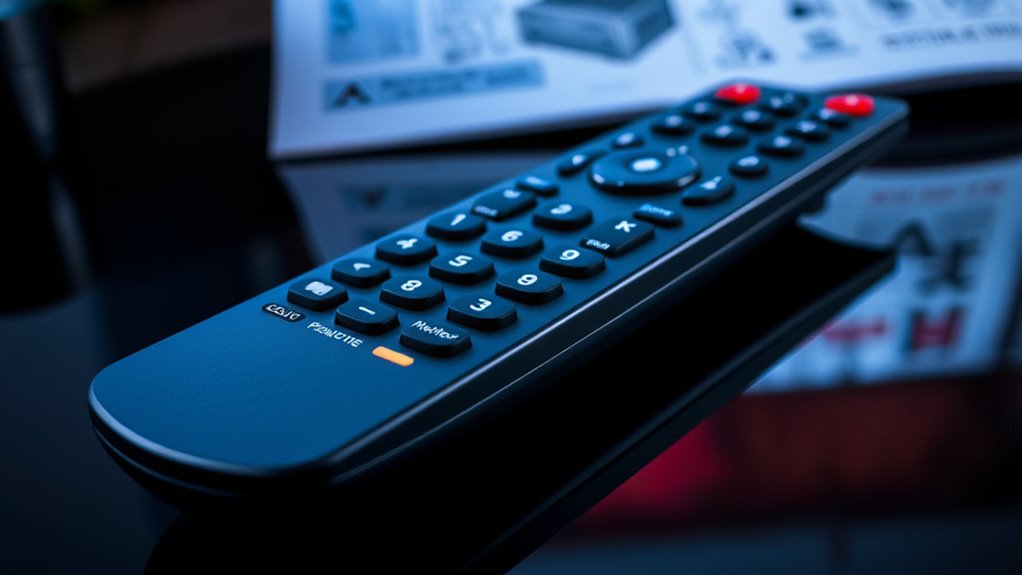
Once you’ve confirmed your universal remote is compatible with your devices, the next step is setting it up properly. This involves remote pairing, which connects the remote to each device. Most remotes offer automatic or manual setup options, but setup troubleshooting may be necessary if the device doesn’t respond. Refer to the table below for common processes:
| Step | Action | Notes |
|---|---|---|
| Power on device | Turn on the device before programming | Ensures proper communication |
| Enter setup mode | Follow manufacturer instructions | Usually involves pressing specific buttons |
| Test remote functions | Verify control commands work | If not, try reprogramming or reset |
| Reset if needed | Restore remote to factory settings | Useful for setup troubleshooting |
Proper setup ensures reliable control and minimizes frustration. Additionally, if you experience issues, retail hours can be helpful to find assistance or visit a store for in-person support.
Debunking Myths About Learning and Auto-Programming Functions
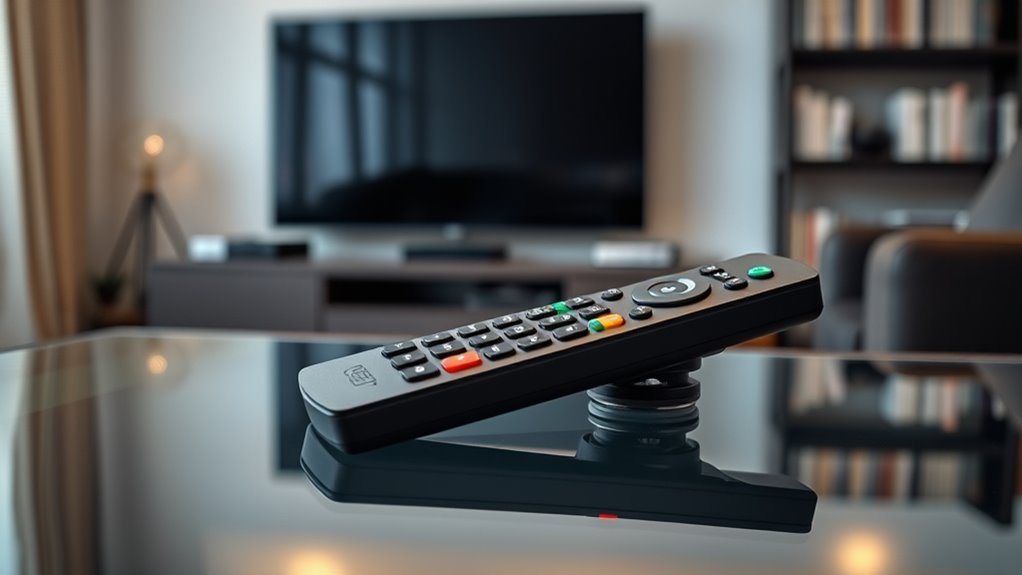
Despite common beliefs, learning and auto-programming functions on universal remotes are not foolproof shortcuts that guarantee instant setup. Many assume these features will seamlessly configure all devices, but that’s not always the case. Learning capability can vary widely between models, and some remotes struggle with complex devices or unique codes. Voice recognition might seem like an easy solution, but it often requires precise commands and isn’t universally reliable. Auto-programming can save time, yet it sometimes fails to capture all functions or requires manual adjustments afterward. Remember, these features are tools to assist, not magic solutions that eliminate the need for troubleshooting or fine-tuning. Understanding industry trends can help you choose the right remote with more accurate expectations.
How to Maximize Your Universal Remote’s Potential
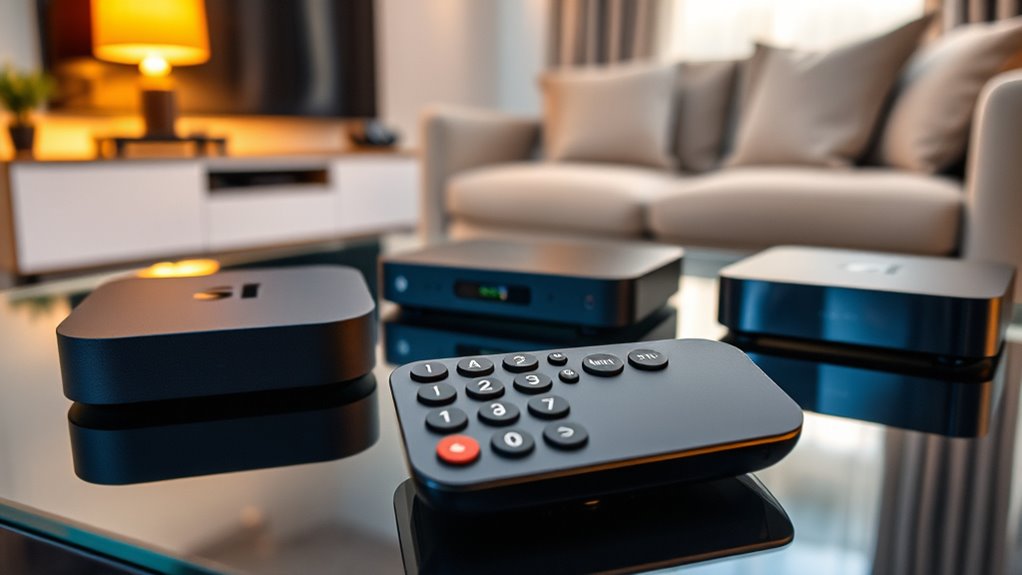
To truly maximize your universal remote’s potential, take the time to customize it for your specific devices and preferences. Start by organizing buttons for quick access to frequently used functions, enhancing remote ergonomics so your experience feels natural. Use the remote’s programming features to create tailored setups for each device, reducing the need to switch between multiple remotes. Also, consider the brand reputation when choosing a remote, as trusted brands often provide more reliable and user-friendly options, guaranteeing long-term satisfaction. Regularly update your remote’s firmware if available, to improve compatibility and performance. By personalizing your remote and selecting reputable brands, you ensure smoother operation, easier control, and a more enjoyable entertainment experience overall.
Selecting the Right Remote: Tips for Informed Choices
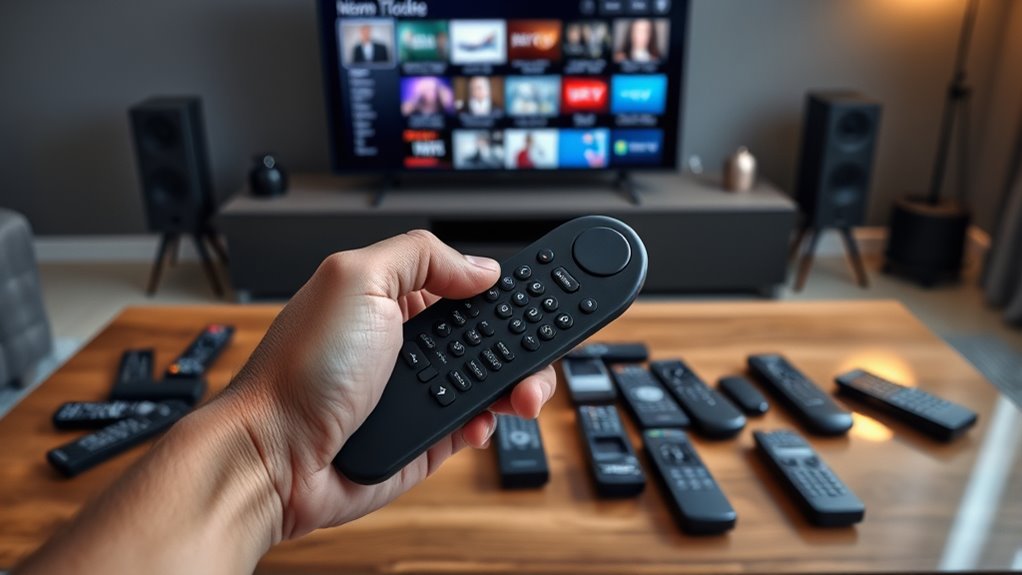
Choosing the right universal remote starts with understanding your specific needs and the devices you want to control. Consider the remote’s ergonomics, guaranteeing it feels comfortable in your hand and easy to use during extended sessions. Aesthetic design also matters; pick a remote that matches your style and fits well within your living space. To make an informed choice, keep these tips in mind:
Choosing a remote that fits your needs and style ensures comfort and seamless control.
- Check device compatibility to ensure it works with all your electronics
- Prioritize remote ergonomics for ease of use
- Choose a design that complements your home’s decor
Frequently Asked Questions
Can Universal Remotes Control Smart Home Devices?
Yes, universal remotes can control smart home devices if they have the right smart home compatibility. Look for remotes that support popular platforms like Alexa or Google Assistant, which enable voice control features. This way, you can easily manage your smart home gadgets with a single remote, simplifying your setup and making your home automation more seamless and convenient.
Are There Universal Remotes Compatible With All TV Brands?
Did you know that over 80% of universal remotes claim compatibility with multiple TV brands? Unfortunately, no universal remote is truly compatible with all TV brands due to brand limitations and varying protocols. You’ll find some remotes work well with popular brands like Samsung or LG, but may struggle with less common ones. Always check the remote’s compatibility list before purchasing to guarantee it fits your specific TV model.
How Secure Are Universal Remote Programming Processes?
Universal remote programming processes are generally secure, but you should be cautious. Many remotes use encryption protocols to protect your data during setup, reducing risks of unauthorized remote access. However, if you connect your remote to untrusted networks or share codes openly, security could be compromised. Always update firmware when available, use trusted devices, and avoid sharing setup information to keep your system safe.
Do All Universal Remotes Support Voice Control Features?
Ever wonder if all universal remotes support voice control? Not quite—they often have voice command limitations, and some models don’t include this feature at all. If voice control is a must, check compatibility beforehand. Keep in mind, using voice commands can drain your remote’s battery life faster. So, don’t assume every universal remote has voice features; confirm features to ensure they meet your needs.
Can Universal Remotes Be Customized for Specific User Preferences?
Yes, many universal remotes support remote customization to suit your user preferences. You can program buttons, create macros, and set up personalized controls for your devices. This flexibility allows you to streamline your entertainment experience, making it easier to access your favorite functions quickly. By customizing your remote, you guarantee it aligns perfectly with how you prefer to operate your devices, enhancing convenience and efficiency.
Conclusion
Think of choosing a universal remote like finding the right key for a lock—it’s about understanding what truly fits. Don’t be fooled by myths or flashy features; focus on compatibility and ease of setup. When you pick wisely, you’ll open effortless control over all your devices. Remember, the right remote isn’t just a gadget—it’s your gateway to simpler, smarter entertainment. Make informed choices, and enjoy the seamless experience you deserve.
